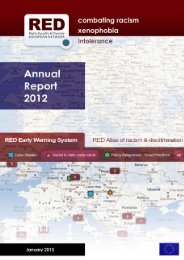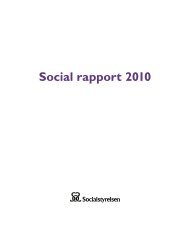R22PITFALLS AND BIASTAXONOMY OF “INTELLECTUAL DISABILITY”Children are typically administered intellectual ability tests (IQ tests) during <strong>the</strong> process <strong>of</strong> assessment forintellectual disability. Almost all countries use <strong>the</strong> following categories <strong>of</strong> <strong>the</strong> American Association <strong>of</strong> Intellectual<strong>and</strong> Developmental Disabilities, The Diagnostic <strong>and</strong> Statistical Manual <strong>of</strong> Mental Disorders IV-TR, <strong>and</strong> <strong>the</strong> InternationalClassification <strong>of</strong> Diseases-10 when labeling children: 6Pr<strong>of</strong>ound: IQ below 20 Severe: IQ 20—34Moderate: IQ 35—49 Mild: IQ 50—70However, <strong>the</strong>se labels, while used internationally to sort people <strong>and</strong> sometimes to stream <strong>the</strong>m into segregatedinstitutional settings, are social constructions. In <strong>the</strong> United States, in exploring <strong>the</strong> overrepresentation <strong>of</strong> children<strong>of</strong> color in special education programs for children with <strong>the</strong> label <strong>of</strong> mild mental retardation, Mercer (1973) <strong>and</strong><strong>the</strong> President’s Committee on Mental Retardation (1969) discussed <strong>the</strong> “six-hour retarded child.” This is a child,usually poor <strong>and</strong>/or <strong>of</strong> color, who is considered to be “retarded” while in school, but who is considered to be “normal”<strong>and</strong> perhaps even a high achiever in his or her family <strong>and</strong> community, such that <strong>the</strong> disability label conferred by<strong>the</strong> school has no function outside <strong>of</strong> <strong>the</strong> school. By <strong>the</strong> 1960s in <strong>the</strong> United States, <strong>the</strong> practice <strong>of</strong> labeling AfricanAmerican children with mild mental retardation (“feeblemindedness”) became an “embarrassment” to <strong>the</strong> governmentin <strong>the</strong> midst <strong>of</strong> <strong>the</strong> Cold War <strong>and</strong> parents became increasingly active to dem<strong>and</strong> services <strong>and</strong> opportunitiesfor <strong>the</strong>ir children who were labeled mentally retarded (Biklen, personal communication July 12, 2006). By 1973,<strong>the</strong> definition <strong>of</strong> mental retardation was revised, from an IQ <strong>of</strong> 85 to 70. With a signature, tens <strong>of</strong> thous<strong>and</strong>s <strong>of</strong>individuals were “cured” <strong>of</strong> mental retardation.While <strong>the</strong> Ministries <strong>of</strong> Education in <strong>the</strong> region stop just short <strong>of</strong> asserting that social or cultural disadvantage ishereditary, family background is repeatedly targeted as <strong>the</strong> cause <strong>of</strong> a child’s school failure. In much <strong>the</strong> sameway that Goddard asserted a causal relationship between feeblemindedness <strong>and</strong> social vice in <strong>the</strong> early twentiethcenturyUnited States, sociologists in <strong>the</strong> United States in <strong>the</strong> late 1960s attributed school achievement not toheredity, but to family <strong>and</strong> social background. Thus, Moynihan (1965) posited that <strong>the</strong> breakdown <strong>of</strong> African Americanfamily, which he in large part attributed to historical <strong>and</strong> structural injustice, was <strong>the</strong> cause <strong>of</strong> <strong>the</strong> breakdown <strong>of</strong>African American culture in <strong>the</strong> United States. Similarly, Coleman (1966) explored <strong>the</strong> correlations <strong>of</strong> poor AfricanAmerican children’s low school achievement, <strong>and</strong> attributed it primarily to <strong>the</strong> family <strong>and</strong> <strong>the</strong> sociocultural milieuin which <strong>the</strong> child lived, using <strong>the</strong> presence <strong>of</strong> a set <strong>of</strong> encyclopedias in <strong>the</strong> home as one <strong>of</strong> his indicators <strong>of</strong>6 At different times in history this taxonomy has been known as “idiot,” “moron,” “imbecile,” <strong>and</strong> “feebleminded.” This taxonomy calls to mind<strong>the</strong> United States <strong>of</strong> <strong>the</strong> late nineteenth through mid-twentieth centuries’ ideas on feeblemindedness <strong>and</strong> degeneracy (Trent 1994).Goddard linked feeblemindedness <strong>and</strong> social vice to heredity; scientists, educators, <strong>and</strong> society increasingly began to view persons identifiedas morons, idiots, or “moral imbeciles” as being drains on society’s resources (as discussed in Gould 1995; <strong>and</strong> Trent 1994). Feeblemindednesswas considered to be both a social burden <strong>and</strong> a social menace (Trent 1994).
R23parental interest in education. These studies were informed by <strong>the</strong> work <strong>of</strong> Lewis (1966/1996) <strong>and</strong> his <strong>the</strong>ory <strong>of</strong><strong>the</strong> “culture <strong>of</strong> poverty,” which he asserts is an intergenerational way <strong>of</strong> life that impedes participation in <strong>the</strong>larger economic system. Children from <strong>the</strong>se families <strong>and</strong> cultures came be known as “culturally deprived.”Goode <strong>and</strong> Eames (1996) critique this view, reframing <strong>the</strong> “culture <strong>of</strong> poverty” as instead a part <strong>of</strong> <strong>the</strong> culture <strong>of</strong>capitalism, in which a belief in <strong>the</strong> culture <strong>of</strong> poverty justifies <strong>the</strong> inequities extant in <strong>the</strong> marketplace. In thisanalysis, families <strong>and</strong> communities are deprived not so much culturally as economically, <strong>and</strong> thus educationally.Blatt (1981, 51), in discussing “cultural-familial retardation” in <strong>the</strong> mid-twentieth century, determines that perceivedcultural <strong>and</strong> educational deficits in a child <strong>and</strong> his or her family are “less a function <strong>of</strong> <strong>the</strong>ir intellect <strong>and</strong>more a function <strong>of</strong> <strong>the</strong>ir realistic attempts to cope with an overwhelming socioeconomic situation.” Ryan (1976)attributes one <strong>of</strong> Coleman’s primary indicators, encyclopedias in <strong>the</strong> home, as more <strong>of</strong> an indicator for socio-economicstatus than parental interest, also asserting that “<strong>the</strong> primary effect <strong>of</strong> poverty, race, <strong>and</strong> family backgroundis not on <strong>the</strong> children, but on <strong>the</strong> teacher who is led to expect poorer performances from black <strong>and</strong> poorchildren” (54). When teachers expect poorer performance from children, as discussed in <strong>the</strong> previous section,teachers tend to create classroom climates where lowered expectations <strong>of</strong> children create self-fulfilling prophecies<strong>of</strong> failure in schools. Similar to notions <strong>of</strong> cultural deprivation in <strong>the</strong> United States, <strong>the</strong> classification <strong>of</strong>“social disadvantage” blames <strong>Romani</strong> families for children’s perceived mental disability through setting out <strong>the</strong>conditions for <strong>the</strong>ir school failure.CULT<strong>UR</strong>AL AND LANGUAGE BIAS IN INTELLIGENCE TESTINGOrigins <strong>of</strong> intelligence testsIn 1905, Alfred Binet introduced <strong>the</strong> first intelligence test, <strong>the</strong> Binet-Simon Scale. Commissioned by <strong>the</strong> Frenchgovernment, <strong>the</strong> purpose <strong>of</strong> this test was to identify pupils in need <strong>of</strong> special academic assistance (Gould 1996;Hayman 1998; Sattler 2008). One <strong>of</strong> <strong>the</strong> ways that Binet went about constructing <strong>the</strong> test items was to askFrench elementary school teachers to tell him <strong>the</strong> types <strong>of</strong> questions or activities that children who had problemsin <strong>the</strong>ir classrooms found <strong>the</strong> most difficult. He included many <strong>of</strong> <strong>the</strong>se items in his scale (for example, countingcoins, repetition <strong>of</strong> digits, naming pictures <strong>of</strong> objects, identifying similar objects, analogies), variations <strong>of</strong> whichare found in modern intelligence <strong>and</strong> ability tests. Thus <strong>the</strong> Binet-Simon Scale “became <strong>the</strong> prototype for subsequentmental ability scales” (Sattler 2008, 218). These subsequent intelligence <strong>and</strong> ability tests have rooted <strong>the</strong>irvalidity in comparison to <strong>the</strong> Binet-Simon items (Humphreys 1984, as cited in Ceci 1991, 719; Gould 1996; Hayman1998, 246). 7 Goddard, who introduced <strong>the</strong> Binet-Simon Scale to <strong>the</strong> United States in 1908, <strong>and</strong> Terman, whorevised <strong>the</strong> Binet-Simon Scales in 1916 (as <strong>the</strong> Stanford-Binet), 1937, <strong>and</strong> in 1960, both worked with Yerkes to7 For a general discussion <strong>of</strong> notions <strong>of</strong> validity <strong>and</strong> reliability, please consult Annex 1.
- Page 3 and 4: R3CONTENTSACKNOWLEDGMENTS 4EXECUTIV
- Page 5 and 6: R5EXECUTIVE SUMMARYThis policy pape
- Page 7: R7For Romani children in Central an
- Page 10 and 11: R10PITFALLS AND BIAS4. Discontinue
- Page 12 and 13: R12PITFALLS AND BIASINTRODUCTIONThe
- Page 14 and 15: R14PITFALLS AND BIASa child is read
- Page 16 and 17: R16PITFALLS AND BIASthe child (Ryan
- Page 18 and 19: R18PITFALLS AND BIASTABLE 2. Placem
- Page 20 and 21: R20PITFALLS AND BIASAMONG THE ROOTS
- Page 24 and 25: R24PITFALLS AND BIASdevelop the ver
- Page 26 and 27: R26PITFALLS AND BIAS2008, 136). Ard
- Page 28 and 29: R28PITFALLS AND BIASBias in test ad
- Page 30 and 31: R30PITFALLS AND BIASWhile the test
- Page 32 and 33: R32PITFALLS AND BIASOF ROMANI CHILD
- Page 34 and 35: R34PITFALLS AND BIAStwo distinct ty
- Page 36 and 37: R36PITFALLS AND BIASPOLICY AND PRAC
- Page 38 and 39: R38PITFALLS AND BIASand had to repe
- Page 40 and 41: R40PITFALLS AND BIASOrientation Tes
- Page 42 and 43: R42PITFALLS AND BIASTABLE 5. Educat
- Page 44 and 45: R44PITFALLS AND BIASCOUNTRY-SPECIFI
- Page 46 and 47: R46PITFALLS AND BIASPLACEMENT IN SP
- Page 48 and 49: R48PITFALLS AND BIASCompulsory scho
- Page 50 and 51: R50PITFALLS AND BIASand Educational
- Page 52 and 53: R52PITFALLS AND BIAS121.1.cc.ii). A
- Page 54 and 55: R54PITFALLS AND BIASTest of School
- Page 56 and 57: R56PITFALLS AND BIASof the overall
- Page 58 and 59: R58PITFALLS AND BIASAS WITH OTHER C
- Page 60 and 61: R60PITFALLS AND BIASfirst grade, or
- Page 62 and 63: R62PITFALLS AND BIASbases listed in
- Page 64 and 65: R64PITFALLS AND BIASof Societies in
- Page 66 and 67: R66PITFALLS AND BIASTABLE 13. Pupil
- Page 68 and 69: R68PITFALLS AND BIASROMANI CHILDREN
- Page 70 and 71: R70PITFALLS AND BIASdetermined to c
- Page 72 and 73:
R72PITFALLS AND BIASdeveloped in th
- Page 74 and 75:
R74PITFALLS AND BIASWechsler Intell
- Page 76 and 77:
R76PITFALLS AND BIAStheir chances t
- Page 78 and 79:
R78PITFALLS AND BIASREPRESENTATION
- Page 80 and 81:
R80PITFALLS AND BIASTABLE 20.Enroll
- Page 82 and 83:
R82PITFALLS AND BIAS
- Page 84 and 85:
R84PITFALLS AND BIASGOOD PRACTICE A
- Page 86 and 87:
R86PITFALLS AND BIASStudent assessm
- Page 88 and 89:
R88PITFALLS AND BIASThe United King
- Page 90 and 91:
R90PITFALLS AND BIASor assistance i
- Page 92 and 93:
R92PITFALLS AND BIASTeachers report
- Page 94 and 95:
R94PITFALLS AND BIASTHE DETERMINATI
- Page 96 and 97:
R96PITFALLS AND BIASintellectual di
- Page 98 and 99:
R98PITFALLS AND BIAS8. Ensure that
- Page 100 and 101:
R100PITFALLS AND BIASANNEX 1:RELIAB
- Page 102 and 103:
R102PITFALLS AND BIAS1. Does the te
- Page 104 and 105:
R104PITFALLS AND BIASANNEX 2:COMPON
- Page 106 and 107:
R106PITFALLS AND BIASFIGURE A4. Sam
- Page 108 and 109:
R108PITFALLS AND BIASAshton-Warner,
- Page 110 and 111:
R110PITFALLS AND BIASCahn, Claude,
- Page 112 and 113:
R112PITFALLS AND BIASD.H. and Other
- Page 114 and 115:
R114PITFALLS AND BIASFigueroa, Rich
- Page 116 and 117:
R116PITFALLS AND BIASGovernment of
- Page 118 and 119:
R118PITFALLS AND BIASHayman, Robert
- Page 120 and 121:
R120PITFALLS AND BIASKovács-Cerovi
- Page 122 and 123:
R122PITFALLS AND BIASMacura-Milovan
- Page 124 and 125:
R124PITFALLS AND BIASMoore, Tom. 20
- Page 126 and 127:
R126PITFALLS AND BIASRadivojevic, D
- Page 128 and 129:
R128PITFALLS AND BIASShepard, Lorri
- Page 130 and 131:
R130PITFALLS AND BIASTomatová, Jan
- Page 132 and 133:
R132PITFALLS AND BIASVláda Česká
- Page 134:
Copyright © 2012 Roma Education Fu




